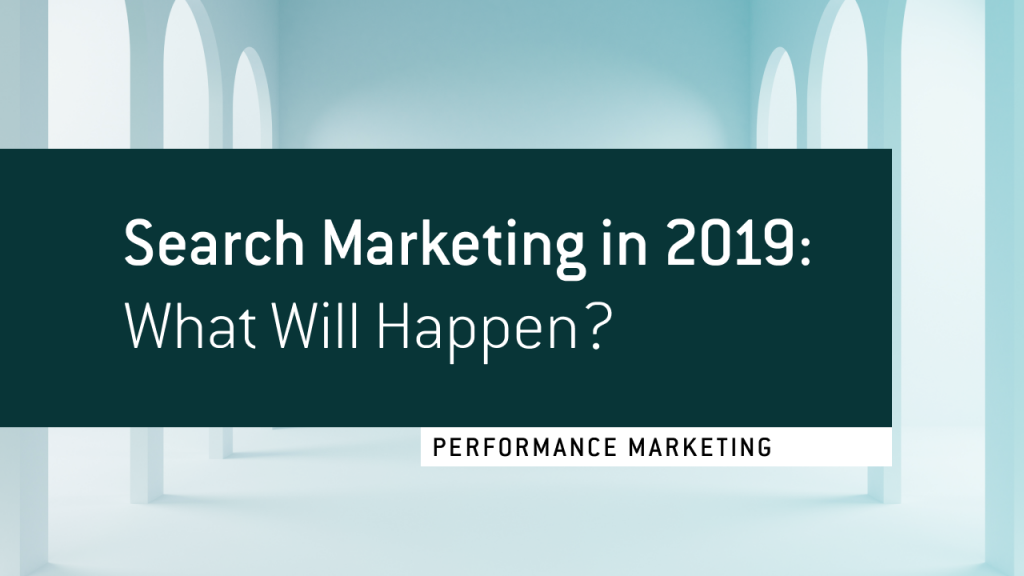With January in full swing, the search marketing industry faces a raft of fresh questions—not least about automation. What will happen in the next 12 months? Might Google Smart Bidding transform the industry? Can we expect anything new in the realm of Sponsored Product Ads? Will online retailers bring the fight to Amazon? And could a shake-up of the status quo be a blessing or burden for retailers?
Crealytics ponders paid search predictions for 2019.
Google Smart Bidding


Google boasts a wealth of experience when it comes to deep learning, so it’s no surprise that Google Smart Bidding (its machine-learning bidding strategy) is getting smarter. The search giant boasts a wealth of real-time bidding signals. And we mean a wealth: it can analyse 70 million signals in 100 milliseconds. Results look increasingly promising for the retailers who’ve tested it, especially those testing Google’s Target ROAS approach. If you’re looking merely for improved Return on Ad Spend results, the tool’s success is tough to argue with.
What, then, can we predict? Actually, two things. Firstly, that Smart Bidding adoption will increase over time, as advertisers rush for an apparent competitive advantage and the ease of letting Google handle bid calculations and optimizations. Few would grumble at a bidding approach that assigns value at the time of auction.
The second prediction is that we expect there to be a counter-reaction to the reaction. Once a significant number of retailers adopt Smart Bidding, the competitive advantages of using it start to disappear. There is no one-size-fits-all bidding strategy (besides, that would be boring). If you have limited changes in your campaigns (and only care about ROAS), sure—go bananas. But of course, the reality is different.
Google Smart Bidding’s Limitations
Smart Bidding’s lack of flexibility means it can’t manage for exceptions. Crucial elements that live outside a ROAS environment (like special promotions) get ignored. The same applies to digital co-op spend, and products with declining inventories.
We’ve said it before: focusing on ROAS targets promotes efficiency at the cost of effectiveness. By extension, feeding Smart Bidding a combination of ROAS and Revenue targets triggers the same result. You have an even faster car, but you go in the wrong direction.
Major retailers don’t use their acquisition budgets to cultivate revenue from existing customers. Rather, their goal is to acquire new customers and decent margins. As a result, the external data sets found outside Google’s algorithm need to be included. Examples include margin, returns, cancellations and Customer Lifetime Value.
TL;DR (Overall Prediction)
Shrewder advertisers will enhance Smart Bidding’s capabilities with more intelligent measurements and smarter eCommerce data integration.
Increased Simplicity and Automation for Search Ads, Audiences
Google first rolled out Dynamic Search Ads (DSA) using page feeds in 2017. It’s not crazy to suggest that this goes further in 2019, with even more automation and alignment to Google Shopping. The scenario might reflect how PLAs work today: a product feed links to an account; and the resulting ads rely on the contents of that feed. For now, it remains a manual process. Might increased automation see the end of users uploading feeds (and selecting pages) themselves?
Responsive Search Ads (RSA) offer further hints at automation, with Google testing its capacities for ad copy. Throw Google some headlines and descriptions and it decides how best to put it into (what it believes will be) the strongest-performing ad copy. With RSA promoted heavily in recent times, could automated ad copy be the norm before 2020? On a separate note, Google’s automated Smart Campaigns has already tickled the interest of many small businesses. It decides both the optimization and ad creatives for users, echoing the automated learning (around structure and query attribution) seen in DSA campaigns.
In Audiences, Google continues to promote In-Market Search Audiences (IMSAs). Yet again, the king of search uses its own user-data to make it work. Performances leave room for improvement, but refinements seem inevitable. Likewise, Affinity audiences (similar to IMSAs) could well expand from Display to Search/Shopping.
TL;DR (Overall Prediction)
Google’s next wave of automated Text Ads simplify user experience.
Text Ad Solutions More Important Than Ever
Text Ad solutions won’t fade away in 2019
In today’s search marketing, Google Shopping trumps the humble Text Ad. But that’s not to say the latter isn’t important. In fact, we think they still have much to offer in the year ahead. Even if text ads aren’t receiving the same portion of budget as 2016, their complexity and nuance hasn’t changed much. Text Ads remain integral for maximum exposure. They offer more information on a product than PLAs, promote a range of on-site discounts, and help advertisers lock in an auction space presence. Despite declining market share, it’s never been timelier to capitalize on Text Ads. Crealytics’ platform offers a good example. Retailers enjoy more structured, granular campaigns with almost zero manual effort required.
This becomes even more pronounced as Google Smart Bidding for Shopping campaigns creates a commoditized bid platform. Retailers seeking competitive differentiation via search will need to find new pockets of growth in their campaigns. Perhaps due to their complexity and relatively low costs, Text Ads provide that opportunity.
TL;DR (Overall Prediction)
The low cost of Text Ads sees retailers continue to use them as part of wider campaigns.
The Rise of Sponsored Products: More Choice, Lower Fees for Retailers


Additional revenue spinners are nothing new. However: we believe improved site monetization will play a huge role in 2019. But how, exactly? A relative latecomer, Sponsored Ads offer huge opportunities for retailers and their brand partners.
For brands, Sponsored Ads offer extra visibility at point-of-sale. Leveraging prime, online real estate helps them generate more product exposure.
As a retailer, Sponsored Ads unlock a new way to monetize your site. With different ad placements (a.k.a. “swim lanes”) accepted as the spring board for partner-driven products, this revenue source sparkles with potential.
The next stage of evolution doesn’t seem far away. Outside of a dominant Amazon (which runs its own Sponsored Product Ads), many retailers rely on a clique of Ad Networks for mediation. Alas, these tend to limit scale and eat up revenues. All of which whets the appetite for a new solution. Our crystal ball predicts greater control over the sales ecosystem, closer relationships with merchandisers and more diversified demand sources. We’ll revisit this theme in future posts, so keep your eyes peeled.
TL; DR (Overall Prediction)
Sponsored Ads’ potential comes to the fore in 2019. A clunky status quo triggers a new, better solution for retailers.
In 2017 Crealytics generated over three billion in ad revenue for retail clients including ASOS, Urban Outfitters, Footlocker, and Lands’ End. For a completely new approach to retail performance advertising, including more on the above topics above, get in touch via info@crealytics.com.





